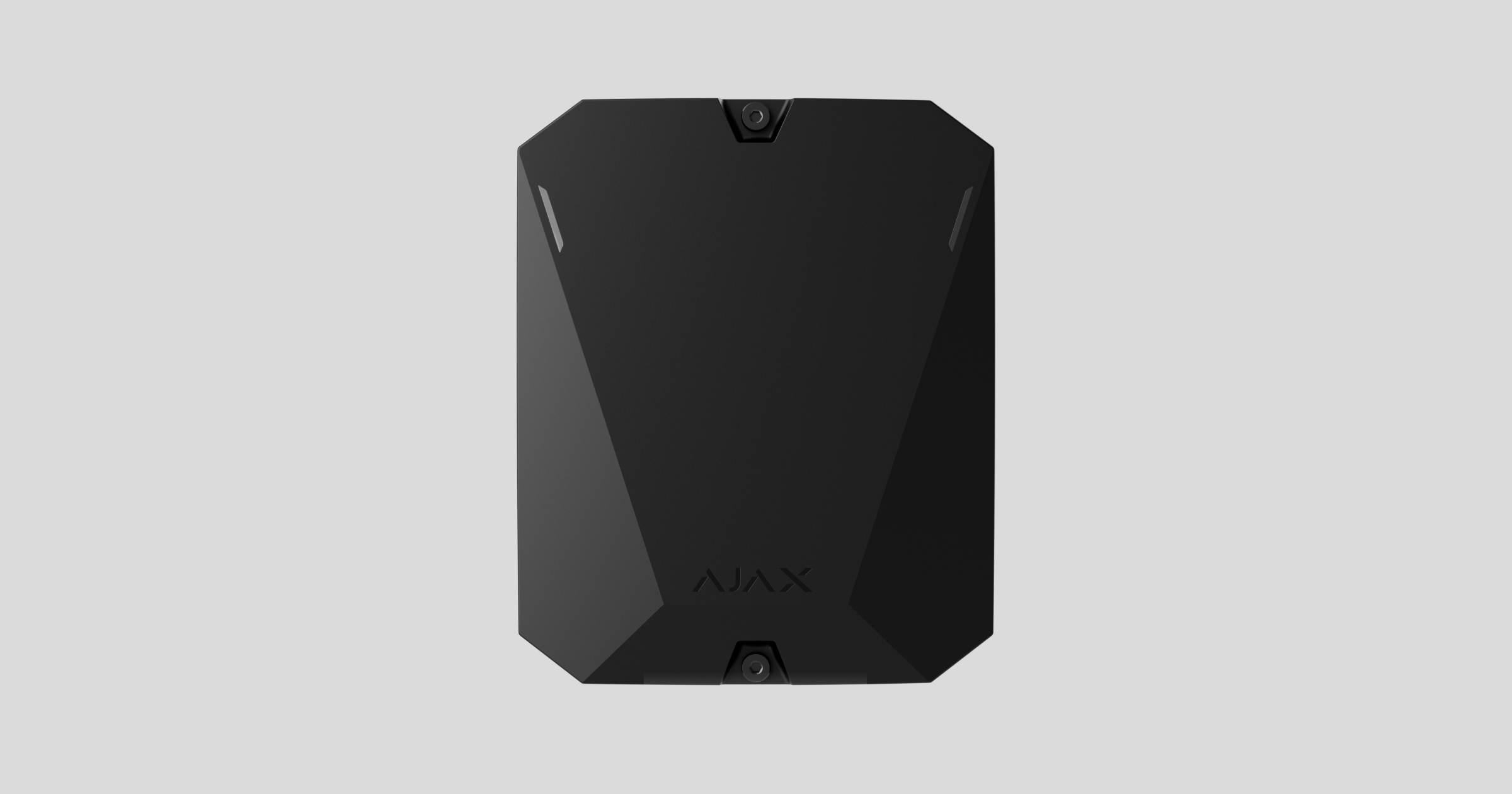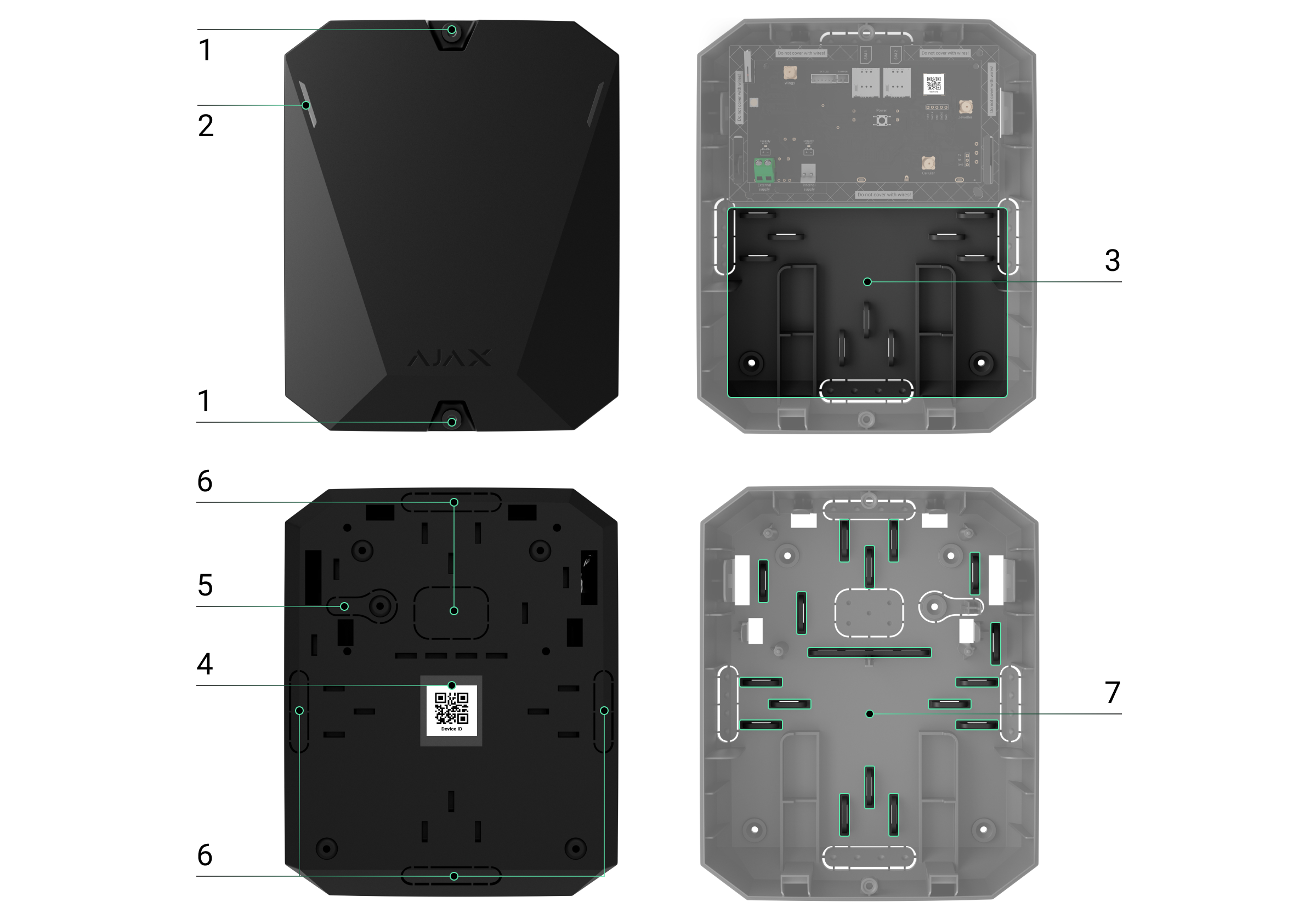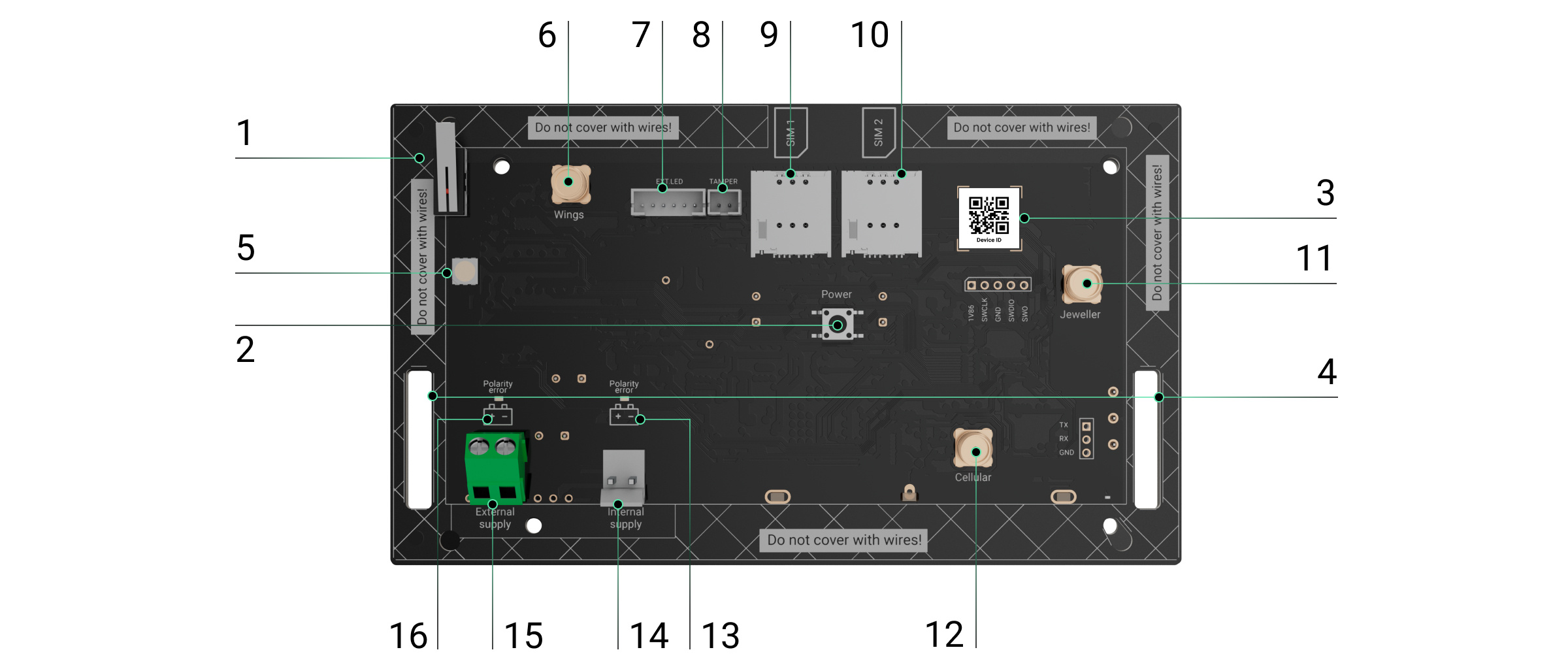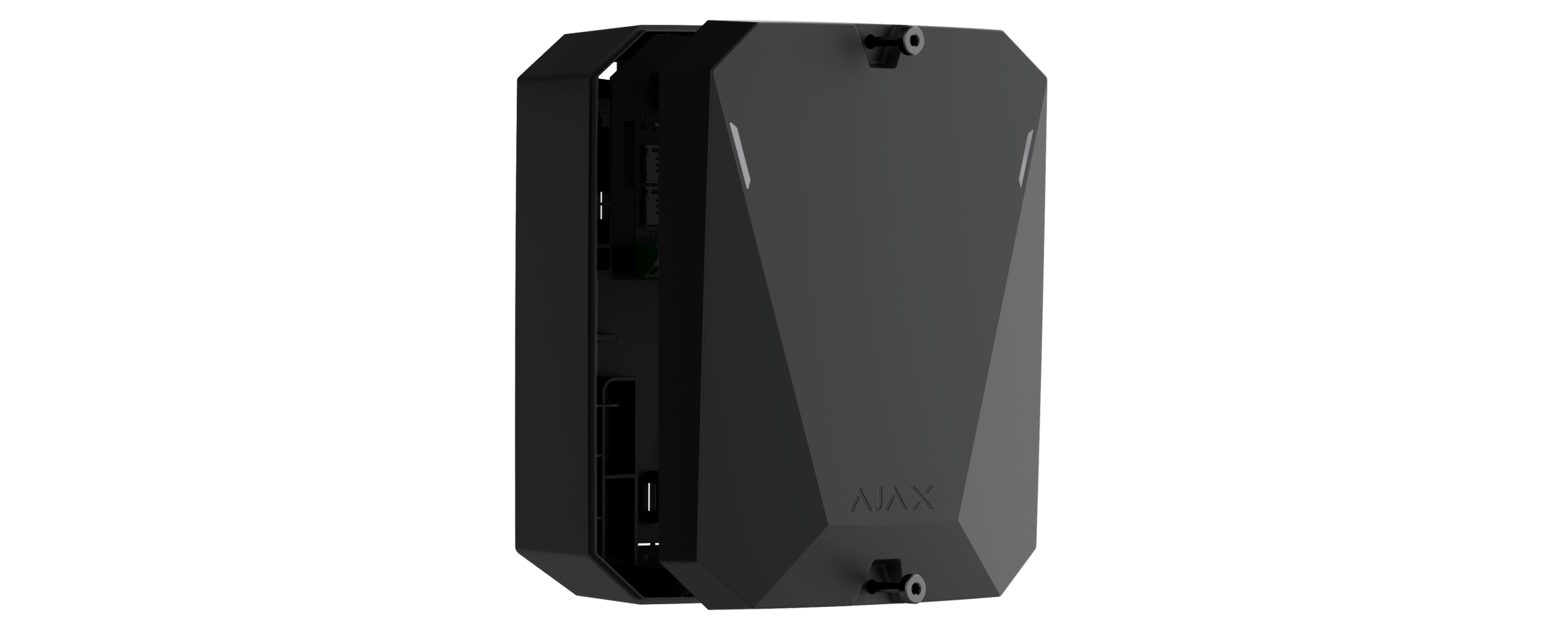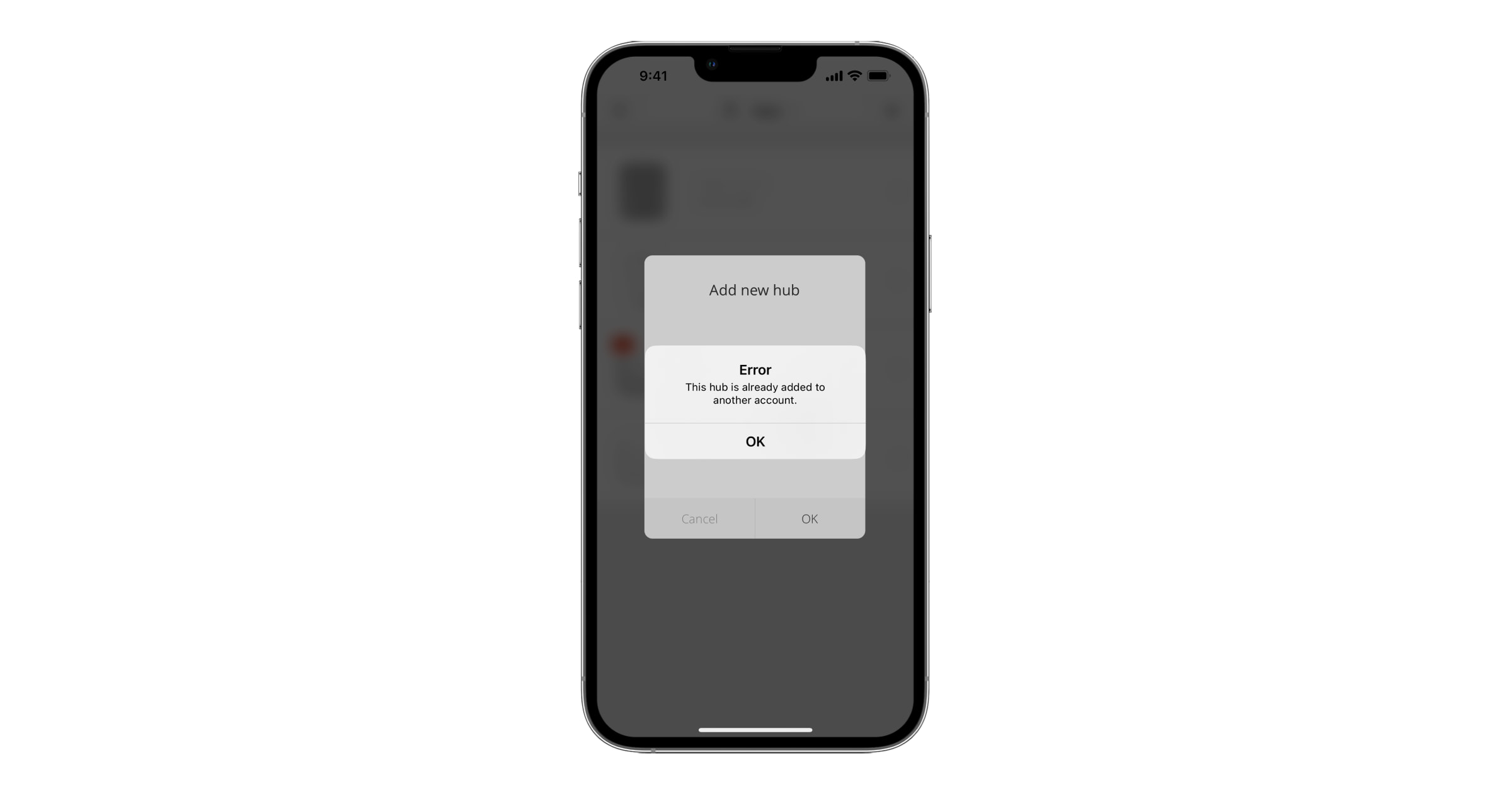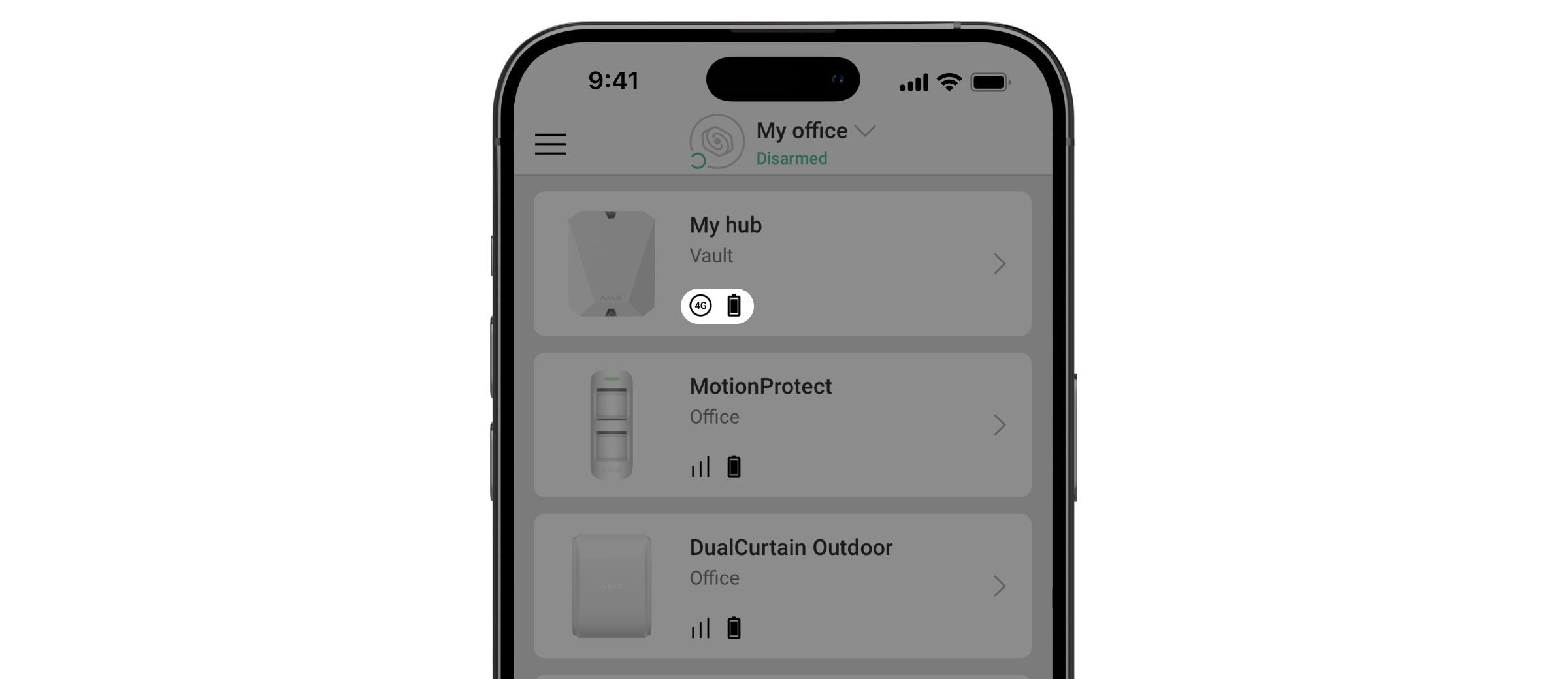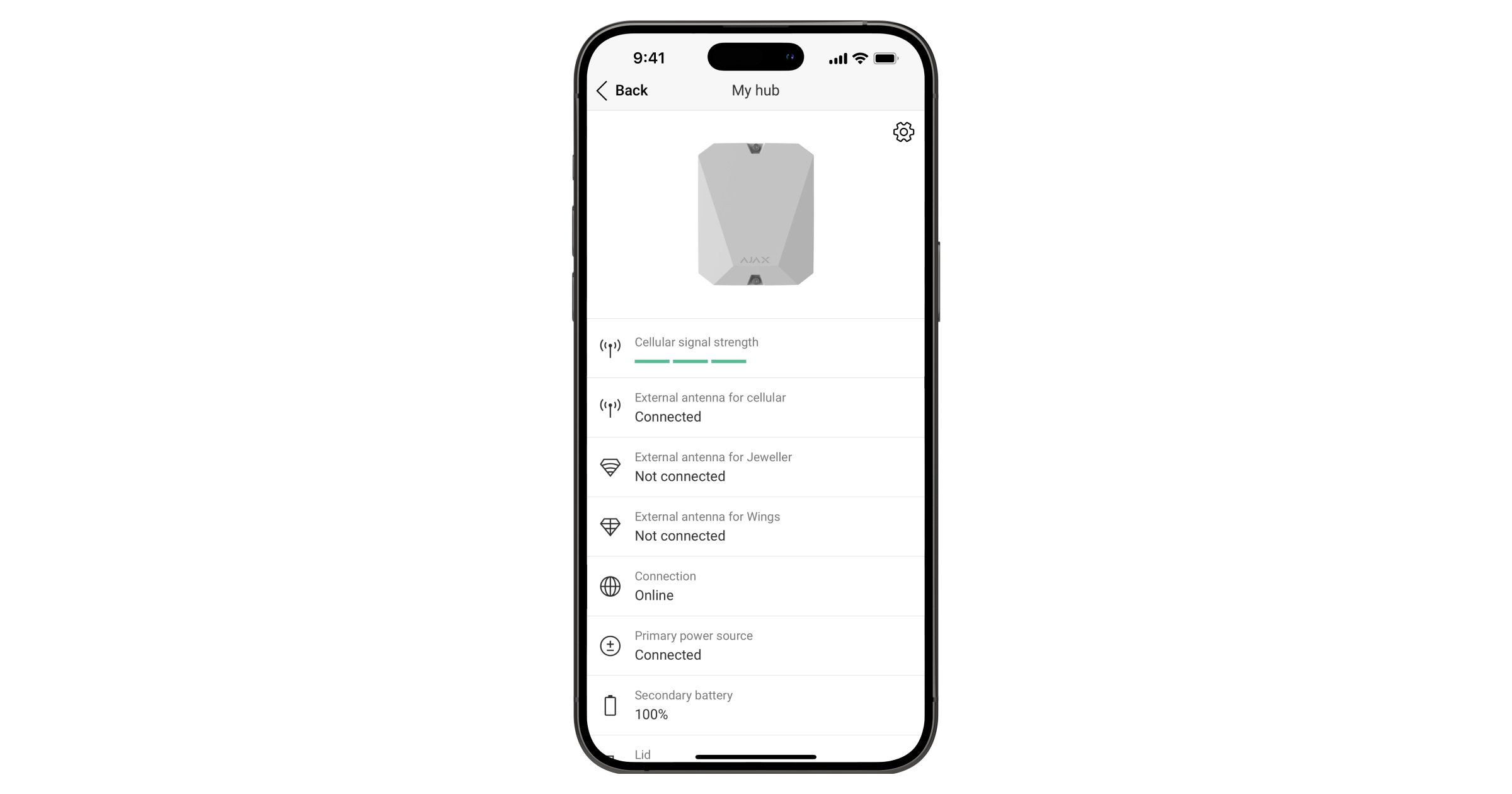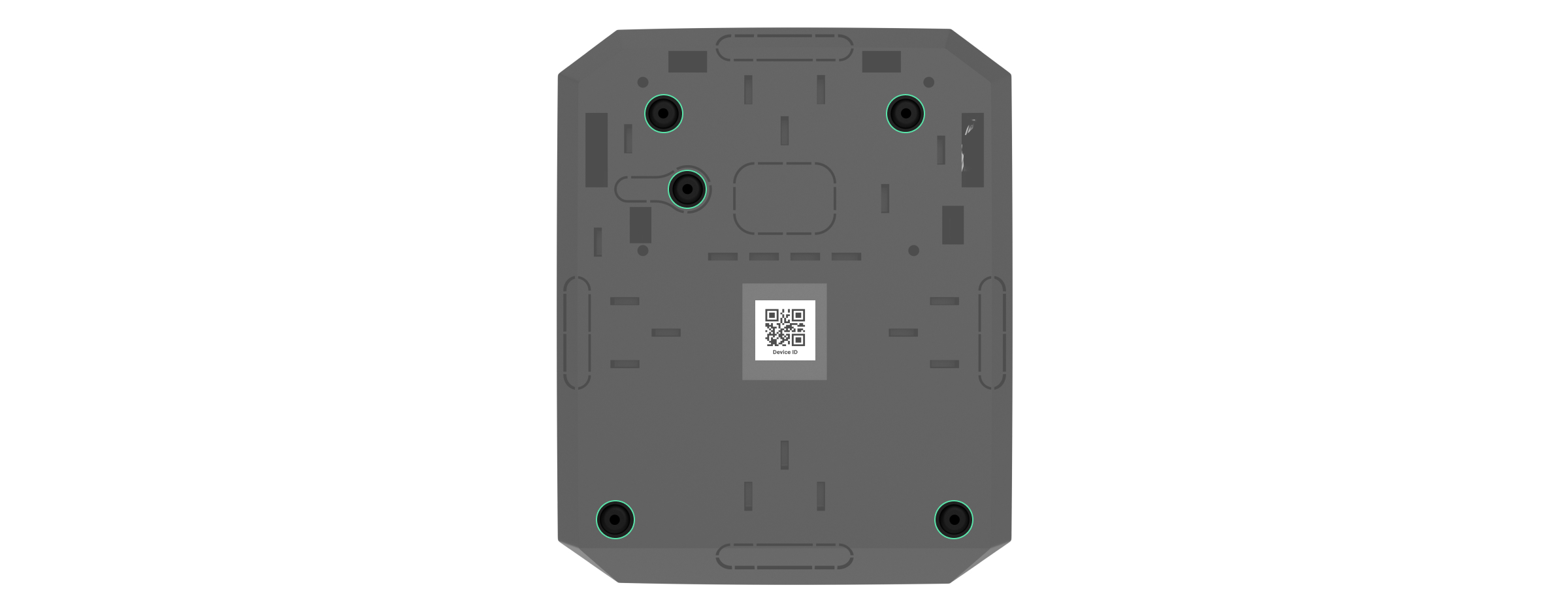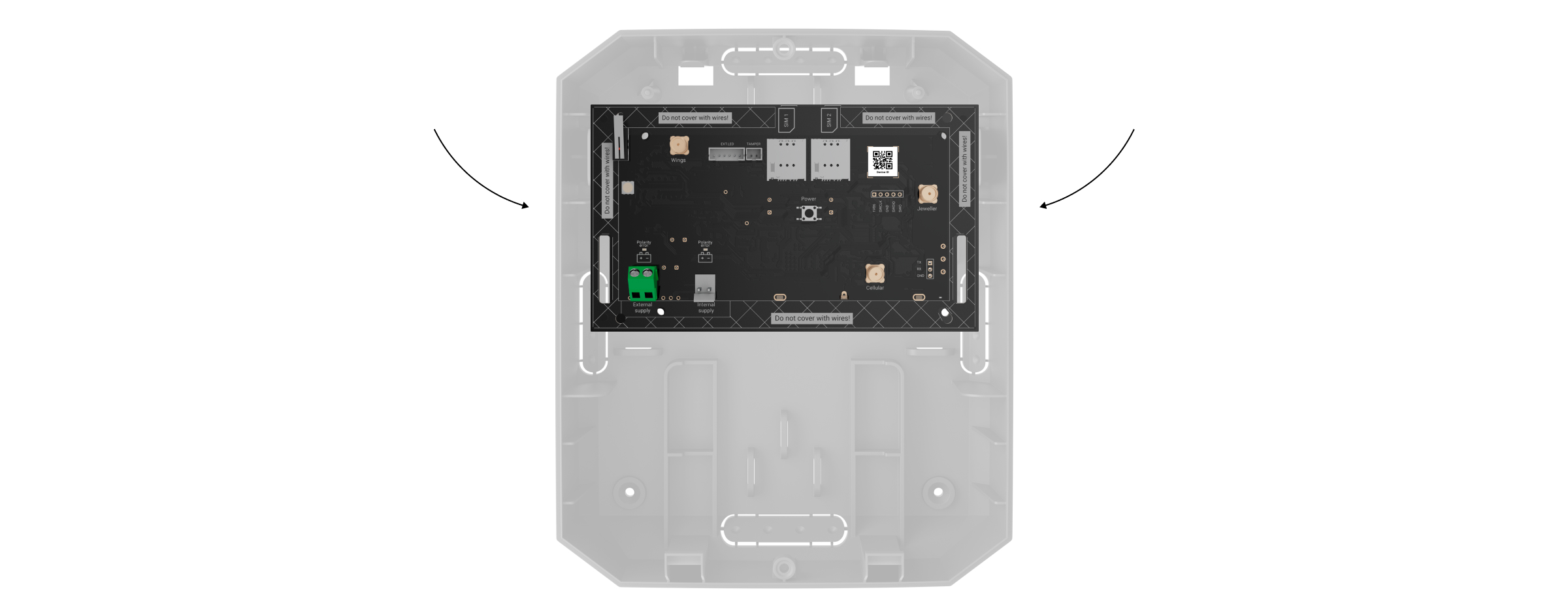O Hub BP Jeweller é um painel central sem fios, alimentado por uma bateria externa e compatível com a verificação por fotografia. O hub liga-se ao servidor Ajax Cloud através de dois cartões SIM (2G/3G/LTE) e possui conectores de antena externa para os canais de comunicação móvel, Jeweller e Wings.
Para estar ligado ao servidor Ajax Cloud, o Hub BP Jeweller necessita de acesso à Internet. O hub utiliza dois cartões SIM como canais de comunicação disponíveis.
Elementos funcionais
Elementos da carcaça
- Parafusos para fixar a tampa da carcaça. Para os desaparafusar, utilize uma chave sextavada (Ø 4 mm).
- Guia de luz para indicar o estado do hub.
- Peça com suportes para uma bateria interna.
A bateria interna não está incluída.
- Código QR e ID (número de série) do painel de controlo.
- Parte perfurada da carcaça. É necessário que o botão de tamper anti-sabotagem seja acionado em caso de tentativa de remoção do dispositivo da superfície. Não partir.
- Partes perfuradas da carcaça para o encaminhamento dos fios de alimentação e dos cabos da antena.
- Fixadores de cabos.
Elementos da placa
- Primeiro botão de tamper.
- Botão de alimentação.
- Código QR. Utilize-o para adicionar o hub ao espaço numa app Ajax.
- Pontos de fixação para fixar a placa Hub BP Jeweller à carcaça.
- Indicador LED.
- Conector de antena externa para o canal de comunicação Wings (conector SMA fêmea).
- Conector para ligar o LED externo ao hub. Não utilizado nesta versão do painel de controlo.
- Conector para fixar a placa de tamper ao hub. Não utilizado nesta versão do painel de controlo.
- Ranhura 1 para micro SIM.
- Ranhura 2 para micro SIM.
- Conector de antena externa para o canal de comunicação Jeweller (conector SMA fêmea).
- Conector de antena externa para canal de comunicação móvel (conector SMA fêmea).
- Indicador de erro de polaridade para uma bateria interna.
- Conector da bateria interna.
- Conector de terminal da fonte de alimentação externa.
- Indicador de erro de polaridade para uma fonte de alimentação externa.
- Segundo botão de tamper.
Princípio do funcionamento
O Hub BP Jeweller é um painel de controlo de um sistema Ajax. Controla o funcionamento dos dispositivos ligados.
Pode ligar até 100 dispositivos Ajax sem fios ao Hub BP Jeweller. Os dispositivos ligados protegem contra intrusões, incêndios e inundações, e permitem controlar os aparelhos elétricos de acordo com os cenários ou manualmente, através de uma app móvel ou ao premir o botão de pânico, LightSwitch ou teclado com ecrã tátil.
Para monitorizar o funcionamento de todos os dispositivos do sistema de segurança, o hub comunica com os dispositivos ligados através de dois protocolos encriptados:
- Jeweller é um protocolo de rádio para transmitir eventos e alarmes a partir de dispositivos sem fios Ajax. O alcance da comunicação é de até 6.550 ft sem obstáculos, como paredes, portas ou construções entre pisos.
- Wings é um protocolo de rádio para a transmissão de fotos dos detetores MotionCam e MotionCam Outdoor. O alcance da comunicação é de até 6.550 ft sem obstáculos, como paredes, portas ou construções entre pisos.
Se um detetor for acionado, o sistema dispara um alarme em menos de um segundo. Em caso de alarme, o hub ativa as sirenes, inicia os cenários e notifica a central recetora de alarmes da empresa de segurança e todos os utilizadores.
Proteção contra sabotagem
O Hub BP Jeweller tem duas ranhuras para cartões SIM para ligação ao servidor Ajax Cloud. Isto permite-lhe ligar o dispositivo a dois operadores de redes móveis diferentes ao mesmo tempo. Se um deles não estiver disponível, o hub muda automaticamente para outro e informa a central recetora de alarmes da empresa de segurança e os utilizadores do sistema.
Quando é detetada uma tentativa de interferência, o sistema muda para uma frequência de rádio inativa e envia notificações para a central recetora de alarmes da empresa de segurança e para os utilizadores do sistema.
O hub verifica regularmente a qualidade da comunicação com todos os dispositivos ligados. Se algum dispositivo perder a ligação ao painel de controlo, após o tempo especificado pelo administrador, todos os utilizadores do sistema (dependendo das definições), bem como a central recetora de alarmes da empresa de segurança, receberão uma notificação sobre o incidente.
Ninguém pode desligar o hub sem ser detetado, mesmo quando a instalação está desarmada. Se um intruso tentar abrir a carcaça do hub, o botão de tamper é imediatamente acionado. A notificação de alarme será enviada à empresa de segurança e aos utilizadores do sistema.
O hub verifica a ligação do Ajax Cloud em intervalos regulares. O período de ping é especificado nas definições do hub. Se for definido um período mínimo de ping, o servidor pode notificar os utilizadores e a empresa de segurança em apenas 60 segundos após a perda da ligação.
OS Malevich
O Hub BP Jeweller é gerido pelo sistema operativo em tempo real OS Malevich. Está protegido contra vírus e ciberataques.
OS Malevich traz novas características e funcionalidades ao sistema Ajax através de atualizações over-the-air. A atualização não requer a intervenção de um técnico de instalação ou de um utilizador.
A atualização demora até 2 minutos com o sistema de segurança desarmado e a fonte de alimentação interna ou externa conectada.
Indicação
O hub tem dois modos de indicação LED:
- Ligação hub — servidor.
- Alertas e avarias.
Ligação hub — servidor
O modo Ligação hub-servidor está ativado por defeito. O LED do hub tem uma lista de indicações que mostram o estado do sistema ou os eventos que estão a ocorrer. O Hub BP Jeweller pode iluminar-se de vermelho, branco, roxo, amarelo, azul ou verde, consoante o estado.
Os utilizadores podem também monitorizar os estados do Hub BP Jeweller em apps Ajax.
| Indicação | Evento | Atenção |
| Ilumina-se a verde. |
O canal de comunicação está ligado: através de um ou dois cartões SIM. |
Quando estiver a funcionar apenas com uma bateria interna, o indicador piscará a cada 10 segundos. |
| Acende-se a vermelho. | O hub não está ligado à Internet ou ao servidor Ajax Cloud. | Quando estiver a funcionar apenas com uma bateria interna, o indicador piscará a cada 10 segundos. |
| Pisca duas vezes a vermelho. | O hub não conseguiu estabelecer uma ligação ao servidor Ajax Cloud utilizando todos os APNs disponíveis. |
Se, ao utilizar o sistema, encontrar uma indicação que não esteja listada neste manual do utilizador, entre em contacto com o serviço de suporte de Ajax.
Alertas e avarias
A função pode ser ativada nas definições do hub na app PRO (Hub → Definições → Serviço → Indicação LED).
| Indicação | Evento | Atenção |
| Alterações do estado do hub | ||
| O LED branco pisca uma vez por segundo. | Armamento em duas fases ou Atraso ao sair. | Um dos dispositivos está a executar Armamento em duas fases ou Atraso ao sair. |
| O LED verde pisca uma vez por segundo. | Indicação de entrada. | Um dos dispositivos está a executar Atraso ao entrar. |
| O LED branco acende-se durante 2 segundos. | O armamento está concluído. | O hub (ou um dos grupos) está a mudar o seu estado de Desarmado para Armado. |
| O LED verde acende-se durante 2 segundos. | O desarme está concluído. | O hub (ou um dos grupos) está a mudar o seu estado de Armado para Desarmado. |
| Alertas e avarias | ||
| O LED vermelho e roxo pisca em sequência durante 5 segundos. | Alarme de emergência confirmado. |
Existe um estado não restaurado após um alarme de emergência confirmado. A indicação é exibida apenas se a opção de restauração após Alarme de emergência confirmado estiver ativada nas definições. |
| O LED vermelho acende-se durante 5 segundos. | Alarme de emergência. |
Existe um estado não restaurado após um alarme de emergência. A indicação não é apresentada se existir um estado de alarme de emergência confirmado. A indicação é exibida apenas se a opção de restauração após Alarme de emergência único estiver ativada nas definições. |
| O LED vermelho pisca. | O número de intermitências é igual ao número de botões de emergência (DoubleButton), o primeiro a gerar o alarme de emergência. | Existe um estado não restaurado após o alarme de emergência confirmado ou não confirmado:
ou
|
| Os LED amarelo e roxo piscam sequencialmente durante 5 segundos. | Alarme de intrusão confirmado. |
Existe um estado não restaurado após a confirmação do alarme de intrusão. A indicação é exibida apenas se a opção de restauração após Alarme de intrusão confirmado estiver ativada nas definições. |
| O LED amarelo acende-se durante 5 segundos. | Alarme de intrusão. |
Existe um estado não restaurado após o alarme de intrusão. A indicação não é apresentada se existir uma condição de alarme de intrusão confirmada. A indicação é exibida apenas se a opção de restauração após Alarme de intrusão único estiver ativada nas definições. |
| O LED amarelo pisca. | O número de intermitências é igual ao número do dispositivo que primeiro gerou o alarme de intrusão. | Existe um estado não restaurado após o alarme de intrusão confirmado ou não confirmado:
ou
|
| Os LED vermelho e azul piscam em sequência durante 5 segundos. | Abertura da tampa. |
Existe um estado de tamper não restaurado ou uma tampa aberta em qualquer um dos dispositivos ou no hub. A indicação é exibida apenas se a opção de restauração após Abertura da tampa estiver ativada nas definições. |
| Amarelo e azul LED piscam em sequência durante 5 segundos. | Outras avarias. |
Existe um estado de falha não restaurado ou uma avaria de qualquer dispositivo, ou do hub. A indicação é exibida apenas se a opção de restauração após Outras avarias estiver ativada nas definições. |
| O LED azul-escuro acende-se durante 5 segundos. | Desativação temporária. | Um dos dispositivos está temporariamente desativado ou as notificações do estado da tampa estão desativadas. |
| O LED azul acende-se durante 5 segundos. | Desativação automática. | Um dos dispositivos é automaticamente desativado por um temporizador de abertura ou pelo número de deteções. |
| Os LED verde e azul piscam em sequência. |
Expiração do temporizador de alarme. |
Apresentado após a expiração do temporizador de alarme (para confirmar o alarme). |
Quando não está a acontecer nada no sistema (sem alarme, avaria, abertura da tampa, etc.), o LED apresenta dois estados de hub.
Acesso às indicações
Os utilizadores de Hub BP Jeweller podem ver a indicação de Alertas e avarias depois de:
- Armar/desarmar o sistema utilizando o teclado Ajax.
- Introduzir o ID de utilizador ou código pessoal correto no teclado e executar uma ação que já tenha sido executada (por exemplo, o sistema está desarmado e o botão de desarmar é premido no teclado).
- Premir o botão SpaceControl para armar/desarmar o sistema ou ativar o Modo Noturno.
- Armar/desarmar o sistema utilizando apps Ajax.
Todos os utilizadores podem ver a indicação Alterações do estado do hub.
Indicação de alerta
Se o sistema estiver desarmado e qualquer uma das indicações da tabela estiver presente, o LED amarelo pisca uma vez por segundo.
Se existirem vários estados no sistema, as indicações são apresentadas uma a uma, na mesma sequência conforme indicado na tabela.
Conta Ajax
Para configurar o sistema, instale a app Ajax e crie uma conta. Os instaladores e as empresas de segurança utilizam as contas Ajax PRO para configurar o sistema para os utilizadores.
Não é necessário criar uma nova conta para cada hub, uma vez que uma conta pode gerir vários sistemas. É possível configurar direitos de acesso separados para cada hub, se necessário.
As definições do utilizador e do sistema, bem como os parâmetros dos dispositivos ligados, são armazenados no hub. Alterar o administrador do hub, adicionar ou remover utilizadores não repõe as definições dos dispositivos adicionados ao hub.
Ligação do hub à Ajax Cloud
Para estar ligado ao servidor Ajax Cloud, o Hub BP Jeweller necessita de acesso à Internet. A ligação é necessária para controlar e configurar o sistema à distância através das apps Ajax, bem como para enviar notificações push aos utilizadores.
O Hub BP Jeweller está ligado à Internet através de uma rede móvel. Para aumentar a fiabilidade e a disponibilidade do sistema, insira os cartões SIM em ambas as ranhuras.
Para ligar o hub através de uma rede móvel, é necessário instalar um cartão micro SIM com o pedido de código PIN desativado e com fundos suficientes na conta para pagar os serviços de acordo com o plano tarifário do operador. Para desativar o pedido de código PIN, insira o cartão SIM no telemóvel.
Uma vez que o hub se liga à Internet apenas através da rede móvel, define automaticamente as definições APN com base no cartão SIM instalado para estabelecer a ligação à Internet. Esta funcionalidade é controlada pela definição Seleção automática de APN e está ativada por defeito para ambos os cartões SIM.
Para ligar o hub a Ajax Cloud:
- Desaperte os parafusos que fixam a carcaça, se esta estiver instalada. Para isso, utilize uma chave sextavada de Ø 4 mm incluída no conjunto completo do hub.
- Retire a tampa da carcaça do hub.
- Instale a placa Hub BP Jeweller na carcaça.
- Ligue a fonte de alimentação aos conectores adequados:
1 — Conector de terminal da fonte de alimentação externa.
2 — Conector da bateria interna. Ligue uma bateria de 12 V⎓.
3 — Indicador de Erro de polaridade para uma fonte de alimentação externa.
4 — Indicador de Erro de polaridade para uma bateria interna.Os indicadores 3 e 4 acendem-se em caso de inversão de polaridade ao ligar a alimentação (quando a fonte de alimentação “-” é ligada ao terminal “+” e vice-versa).
- Instale cartões SIM:
1 — Ranhura 1 para micro SIM.
2 — Ranhura 2 para micro SIM. - Mantenha premido o botão de alimentação do hub. Assim que o hub estiver ligado, o LED na placa do hub acende-se.
- Aguarde até que o painel de controlo esteja ligado à Internet. O LED verde indica que o hub está pronto a funcionar.
Após a ligação à Internet ser estabelecida e o hub ser adicionado a uma app Ajax, é possível configurar manualmente os parâmetros de rede para outro cartão micro SIM. Nas definições do cartão SIM, desative a opção Seleção automática de APN e configure o roaming, APN, nome de utilizador e palavra-passe. Para obter informações sobre estes parâmetros, contacte o serviço de apoio do seu operador móvel.
Não desative a opção Seleção automática de APN nem configure manualmente os parâmetros de rede do cartão SIM atual que fornece a ligação à Internet. Isto pode resultar na perda de ligação, e o hub ficará offline.
Adicionar o hub à app Ajax
Utilize as versões mais recentes de apps Ajax e de OS Malevich para aceder a todas as funcionalidades disponíveis e garantir o funcionamento correto do sistema.
A concessão de acesso a todas as funções do sistema (nomeadamente para visualizar as notificações) é uma condição obrigatória para gerir o sistema Ajax através do smartphone/tablet.
- Abra a app Ajax e inicie sessão na sua conta.
- Selecione um espaço ou crie um novo.
- Abra o menu Adicionar Hub e selecione como pretende adicionar um novo hub: manualmente ou utilizando um tutorial passo a passo.
- Na fase de registo, digite o nome do hub e digitalize o código QR na parte de trás da carcaça (ou introduza o ID manualmente).
- Aguarde até que o hub seja registado e apresentado na app.
Se já existirem utilizadores no hub, o administrador do hub, o PRO com direitos de configuração do sistema ou a empresa de instalação que mantém o hub selecionado podem adicionar a sua conta. Será notificado de que o hub já foi adicionado a outra conta. Entre em contacto com o nosso Suporte técnico para determinar quem tem direitos de administrador no hub.
Adicionar dispositivos
Durante o primeiro registo do hub na app, ser-lhe-á pedido que adicione dispositivos para proteger a sala. No entanto, pode recusar e voltar a este passo mais tarde.
Um administrador ou PRO com direitos de configuração do sistema só pode adicionar o dispositivo quando o sistema está desarmado.
- Abra a app Ajax. Selecione o hub se tiver vários ou se estiver a utilizar a app Ajax PRO.
- Aceda ao separador Salas
.
- Abra a sala e selecione a opção Adicionar dispositivo.
- Dê um nome ao dispositivo, digitalize o código QR (ou introduza o ID manualmente), selecione a sala e passe para a etapa seguinte.
- Quando a app começar a procurar e iniciar a contagem decrescente, ligue o dispositivo: o LED piscará uma vez. Para que a deteção e o emparelhamento ocorram, o dispositivo deve estar localizado dentro da área de cobertura da rede sem fios do hub (numa única instalação protegida).
O dispositivo ligado ao hub aparecerá na lista de dispositivos do hub na app Ajax. Pode encontrar o dispositivo introduzindo parte do nome, modelo ou ID no campo de pesquisa.
Se a ligação falhar à primeira tentativa, desligue o dispositivo durante 5 segundos e volte a tentar.
Avarias
O hub pode notificar sobre avarias. Ao tocar em , abre-se a lista de todas as avarias. O campo Avarias está disponível nos Estados do dispositivo e só é apresentado se for detetada uma avaria, por exemplo:
- Bateria não encontrada.
- A bateria não carrega.
- Erro na memória flash.
Ícones
Os ícones apresentam alguns dos estados do Hub BP Jeweller. Pode vê-los na app Ajax no separador Dispositivos .
| Ícone | Significado |
| O hub funciona na rede 2G. | |
| O hub funciona na rede 3G. | |
| O hub funciona na rede 4G (LTE). | |
| O cartão SIM está avariado ou tem um código PIN configurado. Verifique o funcionamento do cartão SIM no telemóvel e desative o pedido de código PIN. | |
| Nível de carga da bateria do hub. Apresentado em incrementos de 5%. | |
| A bateria interna não está conectada. | |
| A tensão da fonte de alimentação externa é inferior à permitida. | |
|
O hub está diretamente ligado à central recetora de alarmes da empresa de segurança. O ícone não é apresentado se a ligação direta não estiver disponível ou não estiver configurada. |
|
|
O hub não está diretamente ligado à central recetora de alarmes da empresa de segurança. O ícone não é apresentado se a ligação direta não estiver disponível ou não estiver configurada. |
|
| O hub está no estado Modo de poupança. | |
| O hub perdeu a ligação com o servidor Ajax Cloud. |
Estados
Os estados podem ser encontrados na app Ajax:
- Aceda ao separador Dispositivos
.
- Selecione o Hub BP Jeweller na lista.
| Parâmetro | Significado |
| Avaria |
Toque no botão O campo só aparece se for detetada uma avaria. |
| Intensidade do sinal móvel |
A intensidade do sinal da rede móvel SIM ativa. Instale o hub em locais onde o nível de comunicação móvel atinge 2-3 barras. Se o hub estiver instalado num local com uma intensidade de sinal fraca ou instável, não poderá efetuar uma chamada ou enviar um SMS sobre um evento ou alarme. Considere utilizar ExternalAntenna. |
| Antena externa para rede móvel | Estado da ligação da antena externa:
A deteção de quebra da antena externa só é possível se a carcaça do hub estiver corretamente fechada. |
| Antena externa para Jeweller | Estado da ligação da antena externa:
A deteção de quebra da antena externa só é possível se a carcaça do hub estiver corretamente fechada. |
| Antena externa para Wings | Estado da ligação da antena externa:
A deteção de quebra da antena externa só é possível se a carcaça do hub estiver corretamente fechada. |
| Ligação | O estado da ligação entre o hub e Ajax Cloud:
Se o hub não estiver ligado ao servidor, os ícones do hub e de todos os dispositivos ligados tornam-se semi-transparentes na lista de dispositivos. |
| Fonte de alimentação externa | Estado da ligação da fonte de alimentação externa:
Se a tensão não for suficiente, o hub reportará Tensão baixa. |
| Bateria interna |
Com um nível de carga de 20% ou menos, o hub irá reportar uma Bateria fraca. Se a bateria não estiver ligada ao hub, será exibido o estado Bateria não instalada. |
| Tampa | O estado dos tampers que respondem à desmontagem ou à abertura da carcaça do hub:
O hub deteta a abertura da tampa da carcaça se um ou ambos os botões de tamper forem acionados. Se a tampa da carcaça estiver aberta, é impossível detetar a quebra da antena externa. |
| Placa do tamper anti-sabotagem | O estado da ligação da placa de tamper da carcaça à placa do hub:
|
| Dados móveis | Estado da ligação à Internet móvel do hub:
Se a intensidade do sinal móvel atingir 1–3 barras e o hub tiver saldo suficiente e/ou SMS/chamadas de bónus, será possível fazer chamadas e enviar SMS, mesmo que este campo exiba o estado Não ligado. |
| Ativo | Apresenta o cartão SIM ativo:
|
| SIM 1 |
O número do cartão SIM instalado na primeira ranhura. Para copiar o número, toque no mesmo. Se o número de telefone for apresentado como um número Desconhecido, o operador não o gravou na memória do cartão SIM. |
| SIM 2 |
O número do cartão SIM instalado na segunda ranhura. Para copiar o número, toque no mesmo. Se o número de telefone for apresentado como um número Desconhecido, o operador não o gravou na memória do cartão SIM. |
| Ruído médio (dBm) |
Ruído médio no canal de rádio. Medido no local onde o hub está instalado. Os dois primeiros valores mostram o nível nas frequências Jeweller, e o terceiro nas frequências Wings. O valor aceitável é de –80 dBm ou inferior. Por exemplo, -95 dBm é considerado aceitável e 70 dBm é inválido. |
| Central recetora de alarmes | O estado da ligação direta do hub à central recetora de alarmes da empresa de segurança:
Se este campo for apresentado, a empresa de segurança utiliza uma ligação direta para receber eventos e alarmes do sistema de segurança. |
| Ativação programada |
Disponível com o OS Malevich 2.30 e posterior. O estado da funcionalidade de ativação programada. A funcionalidade permite definir a data e a hora em que o hub é ativado por pedido a partir do modo de poupança de bateria e fica ativo para configuração e gestão. Os estados disponíveis são:
Toque em |
| Modelo de hub |
Nome do modelo do hub. |
| Versão do firmware | Versão de hardware do Hub BP Jeweller. Não atualizado. |
| Firmware |
Versão do firmware de Hub BP Jeweller. Atualizações remotas. |
| ID do dispositivo |
Identificador (primeiros 8 dígitos do número de série) do hub. O identificador está localizado na caixa do dispositivo e na placa sob o código QR. |
| IMEI | Um número de série único de 15 dígitos para identificar o modem do hub numa rede GSM. É apresentado apenas quando um cartão SIM está instalado no hub. |
Seleção do local de instalação
Fixe a carcaça do Hub BP Jeweller numa superfície vertical utilizando os fixadores incluídos. Todos os furos necessários para a fixação já foram efetuados na carcaça.
É necessário fixar o hub na vertical para que o tamper responda se alguém tentar retirar um dispositivo. Consulte a documentação da bateria antes de a instalar, porque algumas baterias só podem ser montadas na vertical (com os terminais para cima). Outra posição de instalação pode causar uma rápida degradação da bateria.
É aconselhável escolher um local de instalação onde o hub esteja escondido de olhares indiscretos, por exemplo, numa despensa. Isto ajudará a reduzir a probabilidade de sabotagem ou de inibição no sistema de segurança. Note que o dispositivo se destina apenas a instalação no interior.
Selecione um local onde o hub possa ser ligado à rede móvel. A intensidade do sinal de telemóvel no local de instalação deve ser estável e atingir 2-3 barras. Em locais com fraca receção de sinal, recomenda-se a instalação de uma antena externa. Não garantimos o funcionamento correto do aparelho com uma intensidade de sinal móvel baixa.
Ao escolher um local, tenha em conta a distância entre o hub e os dispositivos sem fios e a presença de obstáculos entre eles que possam interferir com a passagem do sinal de rádio. Esses obstáculos podem incluir paredes, pisos elevados ou objetos grandes na sala. Se necessário, utilize uma antena externa.
Para calcular aproximadamente a intensidade do sinal no local onde os dispositivos sem fios estão instalados, utilize a nossa Calculadora do alcance da comunicação via rádio.
Faça os testes de intensidade do sinal Jeweller e Wings. No local de instalação escolhido, deve ser fornecida uma intensidade de sinal estável de 2–3 barras com todos os dispositivos ligados. Com uma intensidade de sinal de 1 ou 0 barras, não garantimos o funcionamento estável do sistema de segurança.
Se o sistema tiver dispositivos com intensidade de sinal de 1 ou 0 barras, considere a utilização de ExternalAntenna ou a deslocação do hub ou do dispositivo. Se não for possível fazê-lo ou se o dispositivo continuar com um sinal fraco ou instável após ser movido, utilize repetidores.
Instalação do painel de controlo
Durante a instalação e o funcionamento do sistema de segurança Ajax, cumpra as regras e os requisitos dos atos jurídicos regulamentares sobre segurança elétrica. Não desmonte o dispositivo enquanto este estiver sob tensão nem o utilize com um cabo de alimentação danificado.
Antes da instalação, certifique-se de que selecionou o local ideal para o dispositivo e que este cumpre os requisitos deste manual.
Para instalar o Hub BP Jeweller:
- Prepare previamente as saídas dos cabos, partindo cuidadosamente as partes perfuradas da carcaça do Hub BP Jeweller.
- Fixe a carcaça na superfície vertical no local de instalação escolhido com os parafusos incluídos, utilizando todos os pontos de fixação. Um deles encontra-se na parte perfurada por cima do tamper — é necessário para acionar o tamper no caso de qualquer tentativa de desprender a carcaça do hub.
- Coloque a placa Hub BP Jeweller nos suportes da carcaça.
- Conecte uma fonte de alimentação externa de 6–12 V⎓.
- Conecte uma bateria interna de 12 V⎓. Não conecte fontes de alimentação de terceiros, uma vez que isso pode provocar a falha do hub.
Utilize uma bateria de 12 V⎓. As dimensões máximas da bateria que pode ser instalada na carcaça são 5,94“ × 2,55” × 3,70″ e o peso é de 11 lb. Para tal configuração de bateria, são fornecidos suportes especiais na caixa do hub.
- Se necessário, ligue a ExternalAntenna à porta de comunicação adequada.
Antes da instalação, certifique-se de ler o manual do utilizador da antena.
- Ligue o hub.
- Instale a tampa na carcaça do hub e fixe-a com os parafusos incluídos.
- Verifique o estado da carcaça do hub na app Ajax. Se a app mostrar um alarme de tamper, verifique o aperto da carcaça do hub.
Onde não instalar o hub
- No exterior. Isto pode resultar numa falha do painel de controlo.
- Perto dos objetos metálicos e dos espelhos. Podem causar atenuação ou blindagem do sinal de rádio. Isto pode resultar na perda de ligação entre o hub e os dispositivos Ajax sem fios. Se for necessário instalar em tais condições, utilize ExternalAntenna para ultrapassar a interferência de sinal.
- Em locais com elevados níveis de interferências rádio. Isto pode resultar na perda de ligação entre o hub e os dispositivos Ajax sem fios ou em falsas notificações sobre inibição do sistema de segurança. Se necessário, utilize ExternalAntenna para deslocar o local de receção.
- A menos de 3 ft de distância do router e de cabos de alimentação. Isto pode resultar na perda de ligação entre o hub e os dispositivos sem fios.
- A menos de 3 ft de distância de dispositivos Jeweller. Isto pode resultar na perda de ligação entre o hub e estes dispositivos.
- Em locais onde o hub terá uma intensidade de sinal de 1 ou 0 barras com dispositivos ligados. Isto pode resultar na perda de ligação entre o hub e estes dispositivos. Utilize ExternalAntenna se necessário.
- Dentro de instalações com temperatura e humidade fora dos limites permitidos. Isto pode resultar numa falha do painel de controlo.
- Em locais sem sinal móvel ou com 1 barra de intensidade do sinal. Não garantimos o funcionamento correto do dispositivo com uma intensidade de sinal móvel baixa. Utilize ExternalAntenna se necessário.
Definições do hub
As definições podem ser alteradas na app Ajax:
- Selecione o espaço se tiver vários ou se estiver a utilizar uma app PRO.
- Aceda ao separador Dispositivos
.
- Selecione o Hub BP Jeweller na lista.
- Aceda a Definições tocando no ícone de engrenagem
no canto superior direito.
- Defina os parâmetros necessários.
- Toque em Voltar para guardar as novas definições.
O nome do hub é apresentado no texto do SMS e da notificação push. O nome pode conter até 12 caracteres cirílicos ou até 24 caracteres latinos.
Seleção da divisão virtual do hub. O nome da divisão é apresentado no texto do SMS e da notificação push.
Configuração de ligações e contas de controlo.
Definições do modem
- Dados móveis — não podem ser desativados.
- Roaming — se estiver ativado, um cartão SIM instalado no hub pode funcionar em roaming.
- Ignorar erro de registo de rede — quando esta definição está ativada, o hub ignora os erros quando tenta estabelecer ligação através de um cartão SIM. Ative esta opção se o cartão SIM não conseguir ligar-se à rede.
- Desativar a verificação da comunicação com o operador — quando esta definição estiver ativada, o hub ignora os erros de comunicação do operador. Ative esta opção se o cartão SIM não conseguir ligar-se à rede.
Cartões SIM
- SIM 1 e SIM 2 — exibe o número de cartões SIM instalados. Toque no campo para aceder às definições do cartão SIM.
Definições do cartão SIM
- APN, Nome de utilizador e Palavra-passe — definições para ligação à Internet através de um cartão SIM. Para saber as definições do seu operador de telemóvel, contacte o serviço de apoio do seu fornecedor.
- Seleção automática de APN — se esta opção estiver ativada, o ponto de acesso é definido automaticamente com base no cartão SIM instalado.
Utilização de dados móveis
- Entrada — a quantidade de dados recebidos pelo hub. Apresentado em KB ou MB.
- Saída — a quantidade de dados enviados pelo hub. Apresentado em KB ou MB.
Lembre-se que os dados são calculados pelo hub e podem diferir das estatísticas do seu operador.
Repor estatísticas — repõe as estatísticas sobre o tráfego de entrada e saída.
Verificar o saldo
Introduza o código USSD de verificação do saldo (fornecido pelo seu operador) e toque em Verificar saldo.
Tipo de comunicação
É possível selecionar a antena preferida a utilizar para a transmissão de dados móveis:
- Comutação automática entre antenas — o hub dará prioridade à antena externa se esta estiver disponível (ligada e sem danos).
- Externa — o hub não muda para uma antena interna e tenta trabalhar apenas com a externa.
- Integrada — o hub utiliza uma antena interna.
Esta definição só está disponível nas apps Ajax PRO.
Definição de palavras-passe de teclado para pessoas que não estão registadas no sistema.
Isto é conveniente, por exemplo, para dar a uma empresa de limpeza acesso à gestão da segurança. Sabendo o código de acesso, basta introduzi-lo no teclado Ajax para armar ou desarmar o sistema.
Para definir um código de acesso para uma pessoa não registada no sistema:
- Prima Adicionar código.
- Configure Nome de utilizador e Código de acesso.
- Prima Adicionar.
Se pretender configurar um código de coação, alterar um código de acesso, as definições de acesso a grupos, o Modo noturno, o ID do código, desativar temporariamente ou eliminar este código, selecione-o na lista e efetue as alterações.
Os códigos de acesso criados são válidos para todos os teclados ligados ao hub. Hub BP Jeweller suporta até 50 códigos de acesso.
Definições para armar/desarmar o sistema de forma programada.
Inicia o Teste da zona de deteção para dispositivos ligados. Este teste permite determinar se os detetores funcionam corretamente e define a distância a que registam os alarmes.
Configuração do intervalo de ping entre o hub e o detetor. As definições determinam a frequência com que o hub comunica com os dispositivos e a rapidez com que a perda de ligação é detetada.
- Intervalo de ping do dispositivo, seg — determina a frequência da consulta dos dispositivos ligados pelo hub. O intervalo mais curto (em segundos) significa uma entrega mais rápida dos eventos entre o hub e os dispositivos ligados (36 segundos por defeito).
- Número de pings perdidos para determinar falha de ligação — contador de pacotes não entregues (8 pacotes por defeito).
O tempo antes de disparar o alarme por perda de comunicação entre o hub e o dispositivo é calculado com a seguinte fórmula:
Intervalo de ping do detetor × Número de pings falhados para determinar a falha da ligação
É importante ter em conta que a redução do intervalo de consulta reduz a duração da bateria incluída.
Tenha em atenção que o intervalo de ping pode reduzir o número máximo de dispositivos ligados:
| Intervalo de ping do detetor | Limite de ligação |
| 12 segundos | 39 dispositivos |
| 24 segundos | 79 dispositivos |
| 36 e mais segundos | 100 dispositivos |
Independentemente das definições, é possível adicionar até 10 sirenes, 50 teclados com buzzer integrado e 5 repetidores ao hub.
Deteção de interferências radioelétricas
- Deteção avançada de interferências rádio
- Enviar evento de deteção de interferência de rádio como alarme
Tipo de comunicação
É possível selecionar a antena preferida a utilizar para os canais Jeweller e Wings:
- Comutação automática entre antenas — o hub dará prioridade à antena externa se esta estiver disponível (ligada e sem danos).
- Externa — o hub não muda para uma antena interna e tenta trabalhar apenas com a externa.
- Integrada — o hub utiliza uma antena interna.
Esta definição só está disponível nas apps Ajax PRO.
Grupo de definições de serviços do hub. Estas estão divididas em 2 grupos: definições gerais e definições avançadas.
Definições gerais
Brilho do LED
Permite ao utilizador ajustar o brilho do LED do hub. Definir no intervalo de 1 a 10. O valor predefinido é 10.
Atualizações de firmware
O menu contém as definições de atualização do firmware do hub.
- Atualização automática do firmware configura atualizações automáticas para OS Malevich (ativada por defeito):
- Se ativada, o firmware é atualizado automaticamente quando uma nova versão está disponível. O sistema deve ser desarmado e a alimentação externa deve ser ligada ao hub.
- Se desativada, o sistema não atualiza automaticamente. Se estiver disponível uma nova versão de firmware, a app oferecerá a atualização do OS Malevich.
- Verificar se há uma nova versão permite verificar e instalar manualmente atualizações de firmware quando disponíveis ou atribuídas ao hub. Esta opção só está disponível quando a definição de Atualização automática do firmware está ativada.
Se o firmware do hub estiver desatualizado, poderá ocorrer um erro ao adicionar um dispositivo ao hub. Neste caso, o sistema solicitará ao utilizador que abra a secção Atualização do firmware nas Definições de serviço e verifique se existe uma nova versão do firmware. Se disponível, o utilizador pode prosseguir com uma atualização do firmware por pedido.
Registo do sistema do hub
Os registos são ficheiros que contêm informações sobre o funcionamento do sistema. Podem ajudar a resolver o problema em caso de erros ou falhas.
A definição permite-lhe selecionar o canal de transmissão para os registos do hub ou desativar a sua gravação:
- Desligado
- Rede móvel
O registo é desativado por predefinição porque aumenta o consumo de dados da rede e diminui a duração da bateria. Em caso de erros do sistema, selecione a opção Rede móvel para enviar registos através de redes móveis.
Quantidade de eventos «Enquanto o hub está offline»
Os eventos durante a falha de comunicação com o servidor são registados na memória intermédia do hub e serão entregues às apps Ajax depois de a ligação ser restabelecida.
Esta definição permite-lhe escolher o número dos últimos eventos que o hub irá enviar para as apps Ajax depois de voltar a estar online.
Pode selecionar entre 100 (valor predefinido) e 1.000 eventos com um incremento de 50 eventos.
Verificar o estado da tampa ao desligar
Se a definição estiver ativada, o hub só poderá ser desligado com o botão de alimentação quando a tampa estiver aberta. A definição está ativada por defeito.
Definições avançadas
A lista de definições avançadas do hub depende do tipo de app: padrão ou PRO.
| Ajax Security System | Ajax PRO |
| Ligação ao servidor Sons e alertas Definições de detetores de incêndio Verificação de integridade do sistema |
Assistente de configuração PD 6662 Ligação ao servidor Sons e alertas Definições da bateria Definições de detetores de incêndio Verificação de integridade do sistema Confirmação de alarme Restauração após o alarme Processo de armar/desarmar Desativação automática dos dispositivos Indicação LED |
Assistente de configuração PD 6662
Abre um guia passo a passo sobre como configurar o seu sistema para cumprir a norma de segurança britânica PD 6662:2017.
Esta definição só está disponível nas apps Ajax PRO.
Ligação ao servidor
O menu contém definições para a comunicação entre o hub e o Ajax Cloud:
- Atraso do alarme de falha de ligação ao servidor, s. Trata-se de um atraso para reduzir o risco de um falso alarme associado à perda de ligação do servidor Ajax Cloud. É ativado após 3 consultas sem êxito do servidor do hub. O atraso é definido no intervalo de 30 a 600 s. O valor predefinido recomendado é 300 s.
- Intervalo de consulta hub-servidor, s. Frequência de envio de pings do hub para o servidor Ajax Cloud. É definido no intervalo de 10 a 300 s. O valor predefinido recomendado é 60 s.
O tempo para gerar uma mensagem relativa à perda de comunicação entre o hub e o servidor Ajax Cloud é calculado através da seguinte fórmula:
(Intervalo de ping × 3) + Filtro de tempo
Com as definições predefinidas, o Ajax Cloud comunica a perda do hub em 8 minutos:
(60 s × 3) + 300 s = 8 min
- Receber notificações sobre a perda de ligação ao servidor sem alarme. As apps Ajax podem notificar a perda de comunicação entre o servidor e o hub de duas formas: com um sinal de notificação push padrão ou com um som de sirene (ativado por predefinição). Quando a opção está ativa, a notificação vem com um sinal de notificação push padrão.
- Notificar a perda de ligação através dos canais. O sistema de segurança Ajax pode notificar tanto os utilizadores como a empresa de segurança sobre a perda de ligação, mesmo através de um dos canais de ligação.
Neste menu, pode escolher a perda de ligação dos canais que serão comunicados pelo sistema, bem como o atraso no envio dessas notificações:
- Rede móvel
- Atraso da notificação de perda, min — tempo de atraso antes de enviar a notificação sobre a perda de ligação através de um dos canais de comunicação. Definido no intervalo de 3 a 30 minutos.
O tempo de envio de uma notificação sobre a perda de ligação através de um dos canais de comunicação é calculado com a fórmula:
(Intervalo de consulta × 4) + Filtro de tempo + Atraso da notificação de perda
Sons e alertas
O menu contém os parâmetros de ativação da sirene.
Alertar com sirene
- Se a tampa do hub ou de qualquer detetor estiver aberta. Se estiver ativado, o hub ativa as sirenes ligadas caso a tampa do hub, do detetor ou de qualquer outro dispositivo Ajax esteja aberta.
- Se o botão de pânico da app for premido. Quando a função está ativa, o hub ativa as sirenes ligadas se o botão de pânico tiver sido premido na app Ajax.
- Reiniciar o sinal de alarme aquando do acionamento de cada detetor.
Sinal sonoro com teclado
- Se a bateria de qualquer dispositivo estiver fraca.
- Se algum dispositivo estiver offline.
Esta definição só está disponível nas apps Ajax PRO.
Definições da bateria
O menu contém definições para as fontes de alimentação do hub.
- Tipo de bateria interna. Esta opção permite-lhe selecionar o tipo de bateria adequado para que o hub possa definir o nível de tensão correto para a mesma.
- Bateria de lítio não recarregável.
- Bateria de lítio recarregável.
- Bateria recarregável de chumbo-ácido.
- Outro tipo de bateria. Esta opção permite especificar níveis de tensão personalizados.
- Nível de tensão baixa da bateria interna. Com este nível de tensão, o hub avisa quando a bateria interna está fraca. Esta opção está disponível se a opção Outro tipo de bateria estiver selecionada para o Tipo de bateria interna.
- Tensão de corte da bateria interna. Se o hub for alimentado por uma bateria interna, desligar-se-á automaticamente com esta tensão. Esta opção está disponível se a opção Outro tipo de bateria estiver selecionada para o Tipo de bateria interna.
Se o hub for alimentado apenas por uma bateria interna, a tensão de corte da bateria interna não pode ser definida para um valor superior ao nível de tensão atual da bateria.
- Nível de tensão baixa da bateria externa. Com este nível de tensão, o hub alerta-o quando a fonte de alimentação externa se descarrega.
- Bateria interna. Permite selecionar se a bateria interna é carregada a partir da fonte de alimentação externa.
- Velocidade de carregamento da bateria interna. Permite selecionar a velocidade de carregamento adequada em função do tipo de fonte de alimentação externa. Esta opção está disponível se a opção Bateria recarregável de chumbo-ácido estiver selecionada para o Tipo de bateria interna.
- Poupança de bateria. Permite ativar o modo de poupança de bateria para a fonte de alimentação escolhida.
- Modo de poupança quando funciona com a bateria externa.
- Modo de poupança quando funciona com a bateria interna.
Quando uma ou ambas as opções estão ativadas, é possível configurar:
- Período de atividade. É o tempo durante o qual o hub e os dispositivos adicionados são ativados para enviar eventos aos utilizadores e à CRA.
- De intervalo de consulta do servidor. É o tempo durante o qual o hub comunica com o servidor para confirmar a sua disponibilidade.
- Ativação por SMS. Se ativado, o hub e os respetivos dispositivos podem ser ativados temporariamente ao enviar um SMS com a palavra-passe para o número do cartão SIM do hub.
- Palavra-passe do SMS. A palavra-passe que deve ser incluída no SMS enviado para o número do cartão SIM do hub para ativar o hub por pedido. A palavra-passe deve ter entre 6 e 24 letras, números ou caracteres especiais sem espaços.
Para ativar o hub por SMS, envie um SMS para o número do cartão SIM do hub com o hub ID (ou seja, ID do dispositivo), a palavra-passe SMS e o texto «WFB».
Exemplo de texto de SMS: 000ABC11 12345ab WFB
- 000ABC11 — um ID do hub (ou seja, ID do dispositivo);
- 12345ab — uma palavra-passe de SMS;
- WFB — um texto obrigatório no SMS.
Tenha em atenção que a funcionalidade Ativação por SMS não está disponível se utilizar Ajax SIM.
Definições da bateria estão disponíveis apenas nas apps Ajax PRO.
A funcionalidade Ativação por SMS está disponível com OS Malevich 2.30 e versões posteriores.
Definições de detetores de incêndio
Menu das definições dos detetores de incêndio Ajax. Permite configurar o alarme dos Detetores de Incêndio Interligados.
Esta funcionalidade é recomendada pelas normas europeias contra incêndios, que exigem uma potência de sinal de aviso de, pelo menos, 85 dB a 10 ft da fonte sonora em caso de incêndio. Esta potência sonora acorda mesmo uma pessoa que esteja a dormir profundamente durante um incêndio. Utilizando a app Ajax, o Button ou o KeyPad, pode desativar rapidamente os detetores de incêndio acionados.
Verificação de integridade do sistema
Este parâmetro é responsável por verificar o estado dos detetores de segurança, dispositivos e grupos seguidos antes de armar o sistema. A Verificação da integridade do sistema está desativada por predefinição.
Confirmação de alarme
Esta definição só está disponível nas apps Ajax PRO.
A confirmação de alarme é um evento especial que o hub envia para a CRA e para os utilizadores do sistema se vários dispositivos tiverem sido acionados num determinado período de tempo. Ao responder apenas a alarmes confirmados, a empresa de segurança e a polícia reduzem o número de visitas devido a falsos alarmes.
Restauração após o alarme
Esta definição só está disponível nas apps Ajax PRO.
A funcionalidade não permite armar o sistema caso tenha sido ativado um alarme anteriormente. Para armar, o sistema deve ser restaurado por um utilizador autorizado ou por um utilizador PRO. Os tipos de alarmes que necessitam de restauro do sistema são definidos durante a configuração da função.
A função elimina situações em que o utilizador arma o sistema com detetores que geram falsos alarmes.
Processo de armar/desarmar
Esta definição só está disponível nas apps Ajax PRO.
A primeira opção Conformidade com a norma permite selecionar uma norma específica para configurar o sistema de segurança de acordo com os requisitos existentes. Depois de selecionar o padrão pretendido, o menu apresentará as definições de armar/desarmar adequadas abaixo. Estão disponíveis as seguintes normas:
- EN 50131 — norma europeia para sistemas de alarme de intrusão e de emergência, que também descreve o conceito de graus de segurança.
- PD 6662 — norma britânica para sistemas de alarme de intrusão e de emergência, com o objetivo de reduzir o número de alarmes não confirmados e garantir que a polícia só reage a ameaças reais.
- VdS — norma alemã para sistemas de alarme contra intrusão e de emergência, que regula o processo de armamento/desarmamento.
- ANSI/SIA CP-01-2019 — norma americana para sistemas de segurança que regula as funcionalidades e requisitos para reduzir os falsos alarmes causados por utilizadores ou equipamentos.
EN 50131
Após a ativação de EN 50131, é possível definir os parâmetros das funções Armamento em duas fases, Reinício do tempo de saída e Erro de saída nas definições de armamento, bem como definir o Atraso na transmissão do alarme nas definições de desarmamento.
PD 6662
Após selecionar PD 6662, o menu mostra o número de definições de armamento/desarmamento que permitem configurar o sistema para cumprir os requisitos padrão.
Utilize o guia passo a passo correspondente na app Ajax PRO para uma configuração rápida e conveniente do sistema, de acordo com a norma PD 6662. Aceda a Hub → Definições → Serviço → Assistente de definições PD 6662 e siga as instruções da app.
VdS
Após selecionar VdS, todos os dispositivos do sistema funcionam sem atrasos ao sair, mas os atrasos ao entrar continuam a funcionar.
O sistema verifica automaticamente se todas as portas e fechaduras estão fechadas. A porta está trancada com o Elemento de bloqueio de terceiros ao armar o sistema. Além disso, o sistema verifica se a porta está bloqueada para garantir que o sistema está armado de acordo com o princípio da inevitabilidade (Alemão: Zwangsläufigkeit).
O sistema não pode ser armado se tiver avarias. Se houver alguma avaria ou se a porta não estiver trancada, o sistema notifica o evento de a armar sem sucesso.
ANSI/SIA CP-01-2019
Um sistema Ajax controlado pelo hub com OS Malevich 2.19 ou uma versão posterior pode ser configurado de acordo com os requisitos da norma ANSI/SIA CP-01-2019.
Apenas Hub 2 (4G) Jeweller e Hub 2 Plus Jeweller são certificados de acordo com a norma ANSI/SIA CP-01-2019.
Após selecionar ANSI/SIA CP-01-2019, pode configurar Reinício do tempo de saída e Instalações ocupadas para as definições de armamento. Nas definições de desarme, pode selecionar os dispositivos que devem sinalizar um Cancelamento de alarme ou Interrupção de alarme e ajustar o tempo limite de Prazo de interrupção de alarme.
Além disso, esta norma exige a ativação de várias funcionalidades do sistema, tais como Atraso ao entrar/sair, zonas cruzadas, Desativação automática de dispositivos e teste do sistema. Estas funcionalidades são configuradas nas definições do hub e de determinados dispositivos.
Desativação automática dos dispositivos
Esta definição só está disponível nas apps Ajax PRO.
O sistema de segurança Ajax pode ignorar alarmes ou outros eventos de dispositivos sem os remover do sistema. Em determinadas definições, as notificações sobre eventos específicos do dispositivo não serão enviadas para a CRA e para os utilizadores do sistema.
Também é possível desativar manualmente um dispositivo específico. Saiba mais sobre como desativar dispositivos manualmente aqui.
Indicação LED
Esta definição só está disponível nas apps Ajax PRO.
Neste menu, é possível selecionar os estados e eventos do sistema que os indicadores LED do hub irão apresentar. Pode ser selecionada uma de duas funções:
- Ligação hub-servidor — os LEDs do hub indicam se um hub está ligado à fonte de alimentação e à Internet.
- Alertas e avarias — os LEDs do hub exibem informações sobre alertas e avarias do sistema, alterações no modo de segurança e atrasos ao entrar/sair.
Indicação de pós-alarme
Selecione os eventos que as sirenes ou os teclados com LED incorporado indicarão com uma intermitência dupla regular até o sistema ser desarmado.
- Alarme de intrusão/emergência confirmado.
- Alarme único de intrusão/emergência.
- Abertura da tampa.
Abre o manual do utilizador do Hub BP Jeweller na app Ajax.
Menu para transferir dispositivos e definições de outro hub. Não se esqueça de que está nas definições do hub para o qual pretende importar dados.
Remove a sua conta do hub. Independentemente disso, todas as definições e detetores ligados permanecem guardados.
Definições do espaço
As definições podem ser alteradas na app Ajax:
- Selecione o espaço se tiver vários ou se estiver a utilizar uma app PRO.
- Aceda ao separador Controlo
.
- Aceda a Definições tocando no ícone da engrenagem
no canto inferior direito.
- Defina os parâmetros necessários.
- Toque em Voltar para guardar as novas definições.
Reposição das definições do hub
Repor as definições de fábrica do hub:
- Ligue o hub se este estiver desligado.
- Remova todos os utilizadores e instaladores do hub.
- Mantenha o botão de alimentação premido durante 30 segundos — o indicador LED na placa do hub começará a piscar a vermelho.
- Remova o hub da sua conta.
Funcionalidades adicionais
Ligação de videovigilância
Hub BP Jeweller é compatível com câmaras Ajax e NVRs, bem como com câmaras de terceiros que suportam o protocolo RTSP ou integração SDK.
Câmaras e NVRs que podem ser ligados ao Hub BP Jeweller:
| Dispositivos | Quantidade |
| Câmaras Ajax através de Ajax NVRs | até 224 |
| Câmaras de terceiros através de Ajax NVRs utilizando ONVIF | até 224 |
| Câmaras Ajax autónomas | até 492 |
| Câmaras autónomas de terceiros que utilizam RTSP ou SDK | até 10 |
Cenários
O Hub BP Jeweller permite criar 32 cenários e minimizar o impacto do fator humano na segurança. O hub pode gerir a segurança de toda a instalação ou grupo de acordo com uma programação; ativar a máquina de fumo se os intrusos entrarem na sala; desenergizar a sala e ligar a iluminação de emergência em caso de incêndio; desligar a água em caso de fuga; controlar dispositivos de iluminação, fechaduras elétricas, persianas e portas de garagem – ao alterar o modo de segurança premindo um botão ou através de um alarme de detetor.
Os cenários podem ser utilizados para reduzir o número de ações de rotina e aumentar a produtividade. Os dispositivos de automatização Ajax respondem a alterações na temperatura e na qualidade do ar. Por exemplo, configurar o aquecimento para se ligar a baixas temperaturas, controlar o sistema de abastecimento, o humidificador e o ar condicionado para manter um clima confortável.
Verificação fotográfica
O Hub BP Jeweller suporta os detetores de movimento sem fios MotionCam e MotionCam Outdoor. Quando acionados, os detetores tiram uma série de fotografias que podem ser utilizadas para avaliar o desenrolar dos acontecimentos nas instalações ao longo do tempo. Isto alivia os utilizadores de ansiedade e evita que as empresas de segurança enviem patrulhas desnecessárias.
O detetor ativa a câmara quando está armado e deteta movimento. Apenas os utilizadores com acesso ao historial de eventos e os funcionários autorizados da empresa de segurança podem ver as verificações visuais de alarme, desde que o sistema de segurança esteja ligado à estação de monitorização.
Se a função Foto por pedido estiver ativada, os detetores podem tirar uma foto por comando de um utilizador do sistema ou utilizador PRO com os direitos apropriados. A captura de uma fotografia é sempre registada no historial de eventos do hub.
As fotografias são protegidas por encriptação em todas as fases da transmissão. São armazenadas no servidor Ajax Cloud e não são processadas ou analisadas.
Manutenção
Verifique regularmente o funcionamento do Hub BP Jeweller e dos dispositivos ligados. A frequência ideal dos controlos é de três em três meses. Limpe a carcaça do hub do pó, teias de aranha e outros contaminantes à medida que surgem. Utilize um pano seco e macio adequado para a manutenção do equipamento.
Não utilize substâncias que contenham álcool, acetona, gasolina e outros solventes ativos para limpar o dispositivo.
Características técnicas
Baterias recomendadas
Recomendamos a utilização de baterias alcalinas de zinco-ar para aumentar a duração das baterias. Antes de ligar este tipo de bateria, certifique-se de que retira os autocolantes ou abre as válvulas de corte de ar. Se possível, deixe a bateria ao ar livre durante 2 horas. O ar é necessário para iniciar uma reação química no interior da bateria e garantir o seu bom funcionamento.
Antes de ligar a bateria externa, leia atentamente as instruções do fabricante. Contêm orientações sobre a utilização segura e os parâmetros recomendados.
As baterias de zinco-ar não são recarregáveis. O parâmetro Taxa de carregamento é especificado para casos de utilização em que uma bateria interna recarregável está a ser carregada por uma bateria externa.
Lista de baterias externas de zinco-ar recomendadas para alimentar o Hub BP Jeweller
| Fabricante | Modelo | Tensão, V | Capacidade, Ah | Taxa de carregamento | Meses¹ de funcionamento no modo de funcionamento completo² | Meses¹ de funcionamento no modo de Poupança de bateria² |
| Cegasa | eZ8 12/600 | 12 | 600 | lenta | 18 | 69 |
| Cegasa | eZ8 9/600 | 9 | 600 | lenta | 14 | 56 |
| UPOWER | 8PFP330 | 12 | 330 | lenta | 12 | 49 |
| Masterbattery | MC-ZA1200-7.5 | 7,5 | 1200 | padrão | 19 | 42 |
| Masterbattery | MC-KOMPACT700 | 12 | 600 | padrão | 18 | 42 |
| Masterbattery | MC-KOMPACT800-6V (0,6A) | 6 | 800 | lenta | 19 | 41 |
| Masterbattery | MC-KOMPACT800-6V (1A) | 6 | 800 | padrão | 18 | 41 |
| Masterbattery | MC-ZA800-12 | 12 | 800 | lenta | 18 | 41 |
| Cegasa | eZ8 9/400 | 9 | 360 | lenta | 9 | 38 |
| Masterbattery | MC-KOMPACT600 | 12 | 600 | lenta | 14 | 37 |
| Maxi | ZZ12-600 | 12 | 600 | lenta | 15 | 37 |
| Masterbattery | MC-ZA500-12 | 12 | 500 | desativada | 13 | 35 |
| Masterbattery | MC-ZA400-12 | 12 | 400 | desativada | 11 | 32 |
| Cegasa | E/Z8 7,5/400 | 7,5 | 330 | desativada | 7 | 29 |
| Safire | SF-BATT-75V-3200WH | 7,5 | 430 | desativada | 9 | 27 |
| Masterbattery | MC-ZA300 | 6 | 300 | desativada | 5 | 18 |
¹ A temperaturas de 25 °C.
² A bateria interna não está carregada.
Garantia
A garantia dos produtos da «Ajax Systems Manufacturing» Limited Liability Company é válida durante 2 anos após a compra.
Se o dispositivo não funcionar corretamente, contacte primeiro o Suporte técnico de Ajax. Na maioria dos casos, os problemas técnicos podem ser resolvidos remotamente.
Contactar o Suporte Técnico:
Fabricado por «AS Manufacturing» LLC
